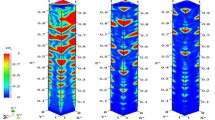Abstract
The system of equations and boundary conditions for the problem of modeling the heat and mass transfer processes in the plane channel of a combined thermal protection system of the radiative-evaporative type is formulated for time-dependent external heat flux and pressure. The effect of the problem parameters on the basic characteristics of these processes is considered. The possibility of nonmonotonic behavior of the evaporation rate and evaporation surface temperature in the presence of a monotonically increasing heat flux is established. A physical explanation of these effects is given.
Similar content being viewed by others
References
J. H. Bridges and F. D. Richmond, “Design considerations for a reentry vehicle thermal protection system,” Technol. Lunar Explor., Academic Press, New York 1963, p. 761.
V. N. Anan'ev, A. P. Kuryachii,et al., “Comparative tests on models of passive and combined thermal protection systems,”Teplofiz. Vys. Temp.,30, 1194 (1992).
I. N. Bobrov and A. P. Kuryachii, “Numerical modeling of the heat and mass transfer processes in an evaporative thermal protection system,”Inzh.-Fiz. Zh.,62, 301 (1992).
A. P. Kuryachii, “Heat and mass transfer associated with low-velocity vapor flow in the plane channel of a thermal protection system of the radiative-evaporative type,”Izv. Ross. Akad. Nauk. Mekh. Zhidk. Gaza, No. 6, 22 (1992).
J. C. Williams, “Viscous compressible and incompressible flow in slender channels,”AIAA J.,1, 185 (1963).
H. Van Ooijen and C. J. Hoogendoorn, “Vapor flow calculations in a flat-plate heat pipe,”AIAA J.,17, 1251 (1979).
G. N. Abramovich,Applied Gas Dynamics [in Russian], Nauka, Moscow (1969).
V. V. Krasnikov,Conductive Drying [in Russian], Énergiya, Moscow (1973).
C. R. Wilke, “A viscosity equation for a gas mixture,”J. Chem. Phys.,18, 517 (1950).
S. Bretsznajder,Własności Gazów i Cieczy [in Polish], Wydawnictwo Naukowo-Techniczne, Warsaw (1962).
M. P. Vukalovich,Thermophysical Properties of Water and Water Vapor [in Russian], Mashinostroenie, Moscow (1967).
O. V. Denisenko and V. P. Provotorov, “Investigation of viscous gas flows at intermediate Reynolds numbers,”Tr. TsAGI, No. 2269, 111 (1985).
I. N. Bobrov and A. P. Kuryachii, “Characteristics of the heat and mass transfer in evaporative thermal protection with variation of the external pressure,”Izv. Ross. Akad. Nauk, Mekh. Zhidk. Gaza, No. 1, 129 (1993).
Additional information
Moscow. Translated from Izvestiya Rossiiskoi Akademii Nauk, Mekhanika Zhidkosti i Gaza, No. 1, pp. 5–12, January–February, 1994.
Rights and permissions
About this article
Cite this article
Kuryachii, A.P. Modeling the unsteady heat and mass transfer in the vapor outlet channel of a radiative-evaporative thermal protection system. Fluid Dyn 29, 3–9 (1994). https://doi.org/10.1007/BF02330613
Received:
Issue Date:
DOI: https://doi.org/10.1007/BF02330613




